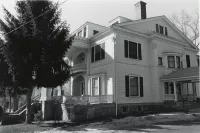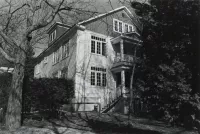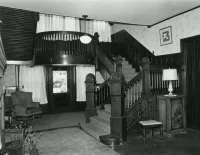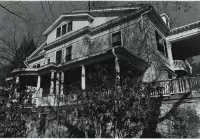Share what you know,
and discover more.
Share what you know,
and discover more.
Aug 19, 1982
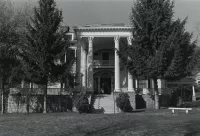
-

- Charmaine Bantugan
National Register of Historic Places - Dr. Carl V. Reynolds House
Statement of Significance: Known today as the Albemarle Inn, the imposing, porticoed residence at 86 Edgemont Road in Asheville was built in 1909 for Dr. Carl V. Reynolds, a native of Asheville and son of an early Buncombe County medical practitioner. The house was one of the first built in the section originally known as Proximity Park, later to become part of the Grove Park neighborhood under the leadership of developer E. W. Grove. Featuring elaborate classical ornament, the house is one of the best examples of the Neo-classical Revival in the city. Dr. Reynolds was known as a "medical statesman" who made significant contributions in the field of public health, serving as city health officer in Asheville from 1903-1910 and 1914-1923, and as a state health officer from 1934-1948. He was instrumental in the founding of the School of Public Health at the University of North Carolina in Chapel Hill. Dr. Reynolds and his wife, Edith lived in the house until 1920 when they sold it to the Grove Park School, a private institution founded in 1900 as the Asheville School for Girls. During the 1920s a classroom building was constructed adjacent to the house. In 1929 the school was leased by the Plonk sisters, educators in the arts who had founded a summer "Southern Workshop" five years earlier. The Plonks operated the school at the site until 1941, changing the name in 1938 to the Plonk School of Creative Arts. In 1941, the Plonk School moved and the Reynolds House became the Albemarle Inn, a rooming house, which it remains today. The most celebrated guest of the Albemarle was Hungarian composer Bela Bartok, who lived here during 1943; here he completed his Third Concerto for Piano, also known as the Asheville Concerto. It is said that the work was inspired by the "concert of birds" that the composer heard outside his window at the Albemarle.
National Register of Historic Places - Dr. Carl V. Reynolds House
Statement of Significance: Known today as the Albemarle Inn, the imposing, porticoed residence at 86 Edgemont Road in Asheville was built in 1909 for Dr. Carl V. Reynolds, a native of Asheville and son of an early Buncombe County medical practitioner. The house was one of the first built in the section originally known as Proximity Park, later to become part of the Grove Park neighborhood under the leadership of developer E. W. Grove. Featuring elaborate classical ornament, the house is one of the best examples of the Neo-classical Revival in the city. Dr. Reynolds was known as a "medical statesman" who made significant contributions in the field of public health, serving as city health officer in Asheville from 1903-1910 and 1914-1923, and as a state health officer from 1934-1948. He was instrumental in the founding of the School of Public Health at the University of North Carolina in Chapel Hill. Dr. Reynolds and his wife, Edith lived in the house until 1920 when they sold it to the Grove Park School, a private institution founded in 1900 as the Asheville School for Girls. During the 1920s a classroom building was constructed adjacent to the house. In 1929 the school was leased by the Plonk sisters, educators in the arts who had founded a summer "Southern Workshop" five years earlier. The Plonks operated the school at the site until 1941, changing the name in 1938 to the Plonk School of Creative Arts. In 1941, the Plonk School moved and the Reynolds House became the Albemarle Inn, a rooming house, which it remains today. The most celebrated guest of the Albemarle was Hungarian composer Bela Bartok, who lived here during 1943; here he completed his Third Concerto for Piano, also known as the Asheville Concerto. It is said that the work was inspired by the "concert of birds" that the composer heard outside his window at the Albemarle.
Aug 19, 1982
National Register of Historic Places - Dr. Carl V. Reynolds House
Statement of Significance:Known today as the Albemarle Inn, the imposing, porticoed residence at 86 Edgemont Road in Asheville was built in 1909 for Dr. Carl V. Reynolds, a native of Asheville and son of an early Buncombe County medical practitioner. The house was one of the first built in the section originally known as Proximity Park, later to become part of the Grove Park neighborhood under the leadership of developer E. W. Grove. Featuring elaborate classical ornament, the house is one of the best examples of the Neo-classical Revival in the city. Dr. Reynolds was known as a "medical statesman" who made significant contributions in the field of public health, serving as city health officer in Asheville from 1903-1910 and 1914-1923, and as a state health officer from 1934-1948. He was instrumental in the founding of the School of Public Health at the University of North Carolina in Chapel Hill. Dr. Reynolds and his wife, Edith lived in the house until 1920 when they sold it to the Grove Park School, a private institution founded in 1900 as the Asheville School for Girls. During the 1920s a classroom building was constructed adjacent to the house. In 1929 the school was leased by the Plonk sisters, educators in the arts who had founded a summer "Southern Workshop" five years earlier. The Plonks operated the school at the site until 1941, changing the name in 1938 to the Plonk School of Creative Arts. In 1941, the Plonk School moved and the Reynolds House became the Albemarle Inn, a rooming house, which it remains today. The most celebrated guest of the Albemarle was Hungarian composer Bela Bartok, who lived here during 1943; here he completed his Third Concerto for Piano, also known as the Asheville Concerto. It is said that the work was inspired by the "concert of birds" that the composer heard outside his window at the Albemarle.
Posted Date
Aug 24, 2023
Historical Record Date
Aug 19, 1982
Source Name
National Register of Historic Places
Source Website
Delete Story
Are you sure you want to delete this story?


